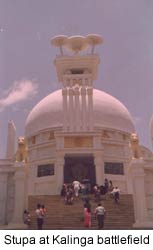

 |  |
continued.....  During Ashoka's reign many large, wealthy cities and even villages in northern India were protected by surrounding walls. These walls had gateways which entered them at intervals. The huge wall that encircled Pataliputra was 40 kilometres long. Government officials, soldiers, scholars, and nobles in their carriages all passed along the city's cobbled streets. The wealthier citizens lived in detached houses with spacious gardens. The main government offices, together with public art galleries and other cultural institutions, were clustered round the royal palace. The palace had a public area where Ashoka held audience, and a private section where the emperor, his family, and attendants lived. The armoury and the treasury were also located there.
During Ashoka's reign many large, wealthy cities and even villages in northern India were protected by surrounding walls. These walls had gateways which entered them at intervals. The huge wall that encircled Pataliputra was 40 kilometres long. Government officials, soldiers, scholars, and nobles in their carriages all passed along the city's cobbled streets. The wealthier citizens lived in detached houses with spacious gardens. The main government offices, together with public art galleries and other cultural institutions, were clustered round the royal palace. The palace had a public area where Ashoka held audience, and a private section where the emperor, his family, and attendants lived. The armoury and the treasury were also located there.
Buddhist teachings, with their emphasis on non-violence and reverence for all forms of life, led Ashoka and his court to become vegetarians. Buddhism also teaches tolerance, respect for holy men (both Hindu and Buddhist), obedience to authority, and regard for inferiors and those in need. Although these principles were not new, Ashoka's great contribution as a ruler was the way he put them into practice. He ensured peace, justice, and good government in what was the largest unified empire in India until the arrival of the British. To publicize his laws, Ashoka had them inscribed on a vast number of stone pillars. These pillars, some of them 12 metres high, were scattered throughout his kingdom and beyond. Ten of them still stand today. The most famous of them is located at Sarnath, near Benares. It is surmounted by stone lions, said to be the finest carvings of the ancient world. Another pillar stands at Rampurva, in northern Bihar. It has a superb bull carved at the top. Parts of Ashoka's inscriptions can still be read on these pillars even though 2,000 years have elapsed since they were carved. Ashoka's fame in his day did much to spread Buddhism throughout Southeast Asia and East Asia. After the emperor's death, Hinduism took over in India again. Nevertheless, the great stupas (shrines to Buddha) can still be seen in India, where they have become centres of pilgrimage. Ashoka built many stupas during his reign. Although his kingdom broke up within 50 years of his death, the Ashokan ideal of a united India remained, as did his doctrine of non-violence. More than 2,000 years later, this became the Indians' most effective weapon of protest in their struggle for independence. In the light of such developments, it seems wholly fitting that Ashoka's lion carvings are the symbol of independent India. next page >> |
Copyright ©2000 indiansaga.info. All rights reserved.
By using this service, you accept that you won't copy or use the data given in this website for any commercial purpose.
The material on indiansaga.info is for informational & educational purpose only.
This site is best viewed at 800 X 600 picture resolution.